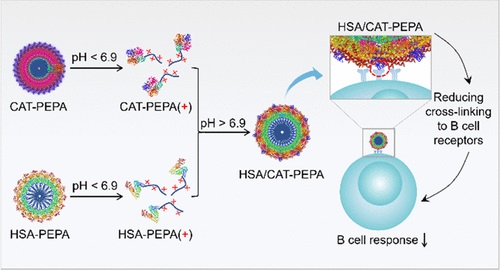
缺氧是肿瘤微环境的特征,与对光动力疗法(PDT)、放疗、化疗和免疫疗法的耐药性有关。过氧化氢酶有可能用于催化内源性H2O2转化为O2以逆转缺氧。然而,将过氧化氢酶有效地输送到肿瘤的缺氧区域是一个巨大的挑战。
该文中,研究人员报道了过氧化氢酶和白蛋白的超酸敏感聚合物偶联物,自组装成对酸性肿瘤微环境有反应的纳米胶束。白蛋白的存在减轻了过氧化氢酶的免疫原性,减少了过氧化氢酶与B细胞受体的交联,从而改善了药代动力学。
纳米胶束的超酸敏感性使其能够有效地逃脱内吞后的溶酶体降解,并渗透到肿瘤内部,在体外和体内逆转缺氧。在患有癌症三阴性的小鼠中,载有光敏剂的纳米胶束有效地积累并渗透到整个肿瘤中,以产生足够量的O2来逆转缺氧,从而增强PDT的功效,而没有可检测的副作用。
这些发现提供了一种自组装的通用策略,以设计低免疫原性超酸敏感的蛋白质-聚合物偶联物共细胞,从而逆转肿瘤缺氧,使肿瘤对PDT敏感。
附:英文原文
Title: Hypoxia Reversion by Low-Immunogenic Ultra-Acid-Sensitive Comicelles of Protein–Polymer Conjugates Sensitizes Tumors to Photodynamic Therapy
Author: Wenchao Huang, Longshuai Zhang, Jiawei Sun, Yuanzi Sun, Like Gong, Sisi Ge, Yinghao Zheng, Weiping Gao, Xunbin Wei
Issue&Volume: March 12, 2024
Abstract: Hypoxia is characteristic of the tumor microenvironment, which is correlated with resistance to photodynamic therapy (PDT), radiotherapy, chemotherapy, and immunotherapy. Catalase is potentially useful to catalyze the conversion of endogenous H2O2 to O2 for hypoxia reversion. However, the efficient delivery of catalase into the hypoxia regions of tumors is a huge challenge. Here, we report the self-assembly of ultra-acid-sensitive polymer conjugates of catalase and albumin into nanomicelles that are responsive to the acidic tumor microenvironment. The immunogenicity of catalase is mitigated by the presence of albumin, which reduces the cross-linking of catalase with B cell receptors, resulting in improved pharmacokinetics. The ultra acid sensitivity of the nanomicelles makes it possible to efficiently escape the lysosomal degradation after endocytosis and permeate into the interior of tumors to reverse hypoxia in vitro and in vivo. In mice bearing triple-negative breast cancer, the nanomicelles loaded with a photosensitizer effectively accumulate and penetrate into the whole tumors to generate a sufficient amount of O2 to reverse hypoxia, leading to enhanced efficacy of PDT without detectable side effects. These findings provide a general strategy of self-assembly to design low-immunogenic ultra-acid-sensitive comicelles of protein–polymer conjugates to reverse tumor hypoxia, which sensitizes tumors to PDT.
DOI: 10.1021/jacs.3c13501
Source: https://pubs.acs.org/doi/abs/10.1021/jacs.3c13501
JACS:《美国化学会志》,创刊于1879年。隶属于美国化学会,最新IF:16.383
官方网址:https://pubs.acs.org/journal/jacsat
投稿链接:https://acsparagonplus.acs.org/psweb/loginForm?code=1000
